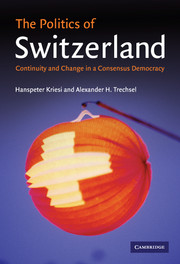Book contents
- Frontmatter
- Contents
- List of figures
- List of tables
- Preface
- List of abbreviations
- 1 The development of the modern Swiss nation-state
- 2 Neutrality
- 3 Federalism
- 4 Direct democracy
- 5 The Swiss system of government
- 6 The party system
- 7 Interest associations and labour relations
- 8 The decision-making process
- 9 Economic policy: liberalization under constraints
- 10 Social policy: the Swiss welfare state
- 11 Foreign policy: Switzerland and the EU
- Appendix
- References
- Index
- References
References
Published online by Cambridge University Press: 05 September 2012
- Frontmatter
- Contents
- List of figures
- List of tables
- Preface
- List of abbreviations
- 1 The development of the modern Swiss nation-state
- 2 Neutrality
- 3 Federalism
- 4 Direct democracy
- 5 The Swiss system of government
- 6 The party system
- 7 Interest associations and labour relations
- 8 The decision-making process
- 9 Economic policy: liberalization under constraints
- 10 Social policy: the Swiss welfare state
- 11 Foreign policy: Switzerland and the EU
- Appendix
- References
- Index
- References
- Type
- Chapter
- Information
- The Politics of SwitzerlandContinuity and Change in a Consensus Democracy, pp. 193 - 217Publisher: Cambridge University PressPrint publication year: 2008



